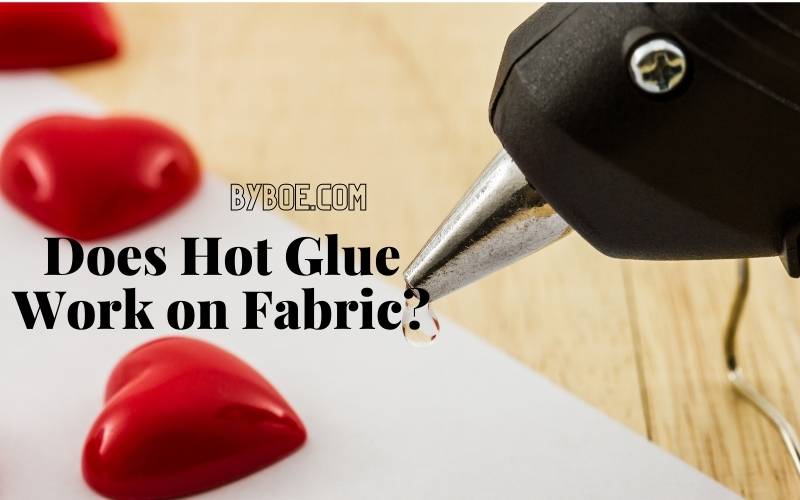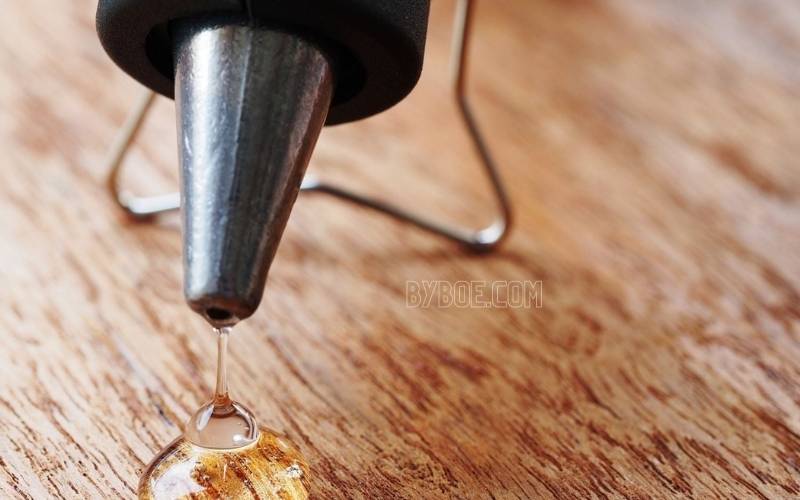Many people have no idea whether or not hot glue works on fabric. This answer is determined by the material of the fabric in question. Knowing which types of fabric glue won’t work can help you save time, money, and resources to make some simple craft items. Keep reading this article, Byboe will let you know Does Hot Glue Work on Fabric? And, if yes, how to use it.
Table of Contents
What is Hot Glue?
Hot glue is often associated with glue guns, glue sticks, crafts, and DIY projects. Is hot glue the same as regular glue sticks?
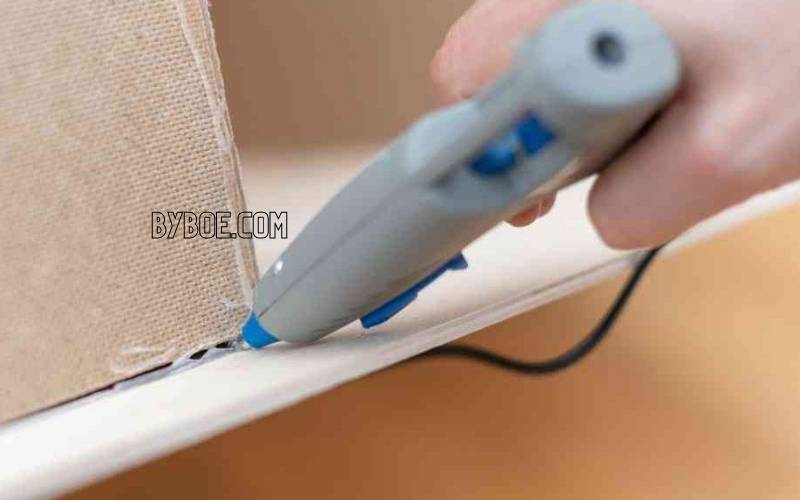
You can find regular glue sticks in twist-up tubes. The glue stick is ideal for minor and everyday applications.
Hot glue (or Hot Melt Adhesives) is made from a mixture of polymers and add-ons like waxes and plasticizers. The elements are heated and then cooled to set. HMAs can also be infused with antioxidants that help preserve the adhesive at high temperatures.
The thermoplastic polymer is an adhesive that provides flexibility and strength to hot glue sticks. The resins offer instant hot-tack while the wax thins the bond to make it easy to apply.
Hot glue sticks work in a molten state. This is why you need a glue gun. Hot glue sticks are made by melting glue sticks with a glue gun.
It can be used for many purposes, including construction and packaging, sealing and sealing school projects, and decorations. These glue sticks are an essential tool for any home, and it’s easy to use for quick solutions.
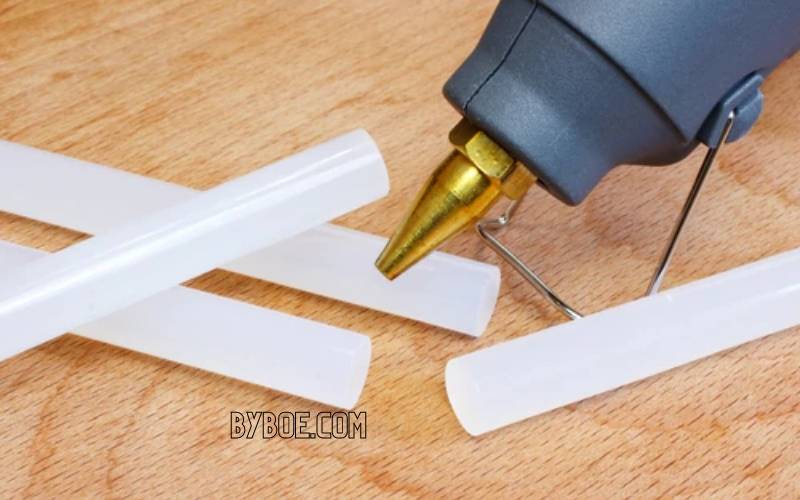
How Does Hot Glue Work?
Hot glue is used to attach different materials or the same material objects. It can be applied to one of the surfaces that is either liquid or molten. It is set or works by heat loss.
After an open time, which is spent applying hot glue to the first material and getting the second material in touch, the hot glue cools, sets, and solidifies. This is how the two materials are joined.
These crucial seconds are critical to ensure that both materials are adequately bonded.
You must take into account a few things to make hot glue sticks work.
The temperature should reach a temperature high enough to melt the glue sufficiently to wet the substrates.
The pressure or compression applied should be sufficient to secure the substrates. This also has a significant impact on the bond to the second object.
Add-on levels are the amounts of hot glue that have been applied at any given time. This affects the adhesive’s ability to wet out to the secondary object. The cooling period will be longer if you use more hot glue.
The hot glue’s temperature, add-on level, and available time impact them. Because hot glue is viscous, you will need to apply more pressure when the available time is longer.
Substrates are the objects you will be binding with adhesive. Highly textured substrates will allow for better mechanical adhesion.
Can You Hot Glue Instead of Sew?
Can you hot glue fabric instead of sewing? You can, but the hot gluing fabric is not recommended for thin fabrics. It would help if you waited until you worked with thicker materials like leather, canvas, or tarp before using your glue gun for fabric. This will ensure the best results.

Do Hot Glue Ruin Clothes?
It depends on the fabric. Certain fabrics cannot withstand the heat of hot glue.
Even with a low-temperature hot glue gun, the fabric can still be damaged.
You can bond acrylic, wool, or modal acrylic fabrics with hot glue. These fabrics are heat-resistant. Although leather can withstand heat, glue could cause it to smell bad.
Hot glue can be used on cotton, linen, or viscose textiles. However, you must be careful about how much hot glue is applied and what add-ons are added. Too much hot glue can cause damage to the fabric.
Hot glue can be used on polyester, but it must be applied carefully since this fabric melts quickly.
Nylon is not recommended for hot glue because it can cause irreparable damage.
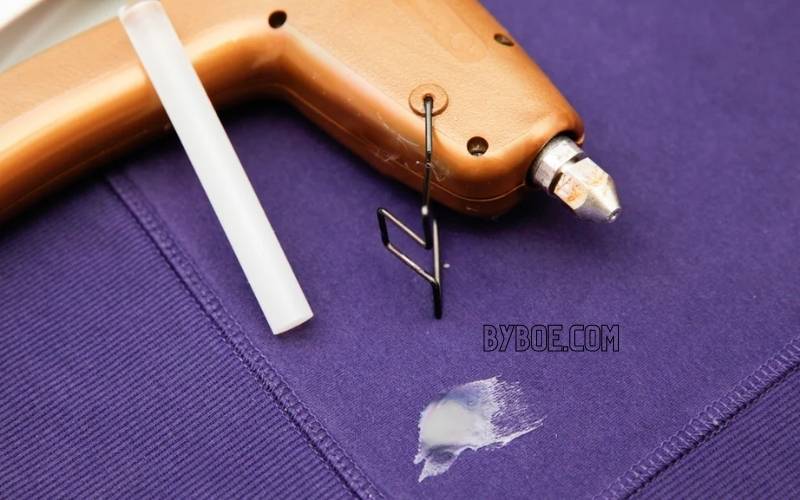
How to Use Hot Glue On Fabric
It is easy to apply hot glue to the fabric. Make sure your material can withstand heat and choose the right gun. Use great compression techniques and applications.
This is a refresher course on hot glue for fabric.
Know Your Products
You need to be able to use hot glue guns correctly.
When gluing fabrics together, use a low-temperature hot glue gun.
You can use the regular glue gun to glue most jobs. However, using the low-temperature hot glue gun is better when working with fabric.
The hot glue gun can also be referred to as a high-temperature hot glue gun. The hot glue gun heat hot melt adhesive automatically at 383°F (195°C).
On the other hand, low-temperature hot glue guns can’t reach more than 266°F (130°C) and still function in binding the fabric substrates together.
These hot glue guns still require a low-temperature glue stick. The glue gun will not allow you to use a regular glue stick.
A dual-temperature hot glue gun is a good choice if you intend to use your glue gun to complete multipurpose projects. This glue gun can be used for fabric or other materials, as it can be set to either high- or low-temperature settings.
Applying the Hot Glue to the Textile
You now know which products you should use and the fabric’s heat tolerance. Now you can glue the material together.
Apply a thin line with your hot melt adhesive along any line, edge, or location where you wish to glue the material.
You can glue two pieces of textile together by applying glue directly to the fabric that can most withstand heat.
If the fabric area you are working with is large, it may be easier to glue it multiple times, dividing that entire surface. Use a divide-and-conquer approach, one inch at a time.
Be aware that hot glue applied to a large area at once will cause other surfaces to cool off already. This means you won’t have the ability to compress the site effectively and adequately all at once.
Compressing It Together
Press the fabric against one another while the glue is still hot. Use materials such as a stack or clamp to press the fabrics together and weigh them.
Do not apply hot glue to fabric using your fingers. You will end up with lots of separated materials and painfully burned fingers.
Because hot glue only takes a few seconds to harden, pressing fabrics together quickly is essential. To create a strong bond, you want to glue the materials together while still hot.
Hot Glue Vs. Fabric Glue
Both hot glue and fabric glue are good options for binding two fabrics together. Hot glue and fabric glue are essential tools for DIY enthusiasts and crafters.
As the name implies, Fabric glue is designed to work with fabrics made from thinner materials. It is 100% washable and drys clear. Many fabric types of glue are intended to be permanent, so it is essential to use with care.
Fabric glue can be used for various purposes, including adding embellishments and other adornments to a fabric.
On the other hand, hot glue works well with both thin and thicker fabrics like leather or heavy gold braids.
The hot melt adhesive is suitable for use on the right fabric. Hot glue can leave dark spots on silky fabrics, while fabric glue can leave marks.
How to Get Hot Glue Off Fabric
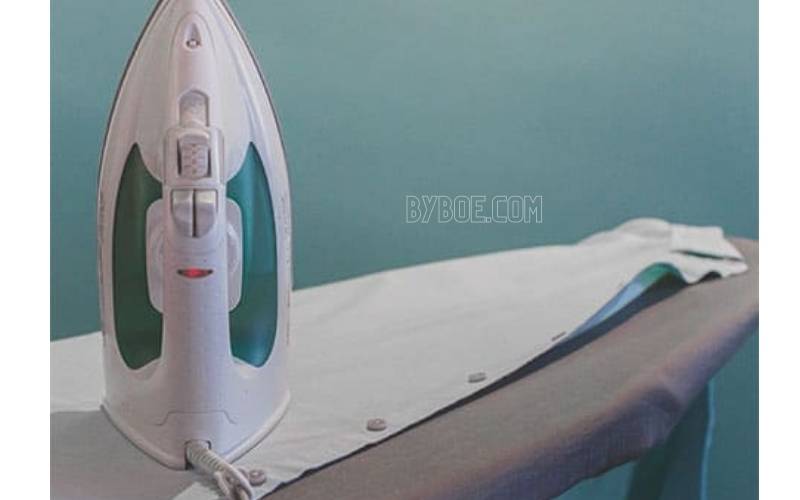
Method 1: How to Get Hot Glue out of Fabric or Carpet: Use an Iron
It is easy to remove hot glue from fabric using an iron. An iron and a cotton cloth/paper bag are all you need. You can also use a newspaper, but without printing.
You will melt the glue on the clothing piece and transfer it to the paper/cloth. You should apply the glue to the cotton cloth or paper and keep it away from your carpet. Easy!
The First Step
First, heat the iron to a temperature where the hot glue is melted but not damaged by your carpet or another textile. If you are working with clothing, it is essential to place the hot glue stain on the dress.
Prepare the Textile
You don’t have to lay any material down to get hot glue off the carpet. However, you will need to follow the rest of these instructions. To soak up the glue, place the paper or cloth you’re using on top.
Use the Hot Iron
Apply the iron for 10-20 seconds, but don’t use steam. Allow the glue to melt on your clothes.
Take the iron off after you see glue transferring and inspect the hot glue stain. If you find any glue residue, place the iron on a different spot on the cloth or paper and continue to apply glue.
If possible, attack both sides.
Flip the fabric if you want to get better results. Flipping both materials can help you remove the glue. Place the paper/cloth on a table or ground. Place the hot glue-stained clothing on top, with the stain facing down.
Apply the iron again to see if it helps. Make sure to select a clean area on the cloth/paper where you can soak the glue.
Method 2: Remove Hot Glue From Fabric Using the Freezer
That’s right. We are going to freeze your clothes. Although this is an excellent method, it takes some time. Once the glue has frozen, hot glue can be pulled off easily.
Put your glue-stained clothing in the freezer. Let it rest for a while until the glue sets. When the glue has hardened, take the item out of the freezer. Use a butter knife or another thin, dull tool to scrap the glue.
The glue should pop off easily. If the glue cannot be put in the freezer, ice cubes can be used to harden it on the carpet. This will allow you to remove the glue from carpet fibers.
You can try steps one and two if there is any glue left. This should be enough.
Method 3: Acetone to Remove Hot Glue from Fabric
You will need acetone, acetone nail varnish remover, and cotton swabs. Goo gone can also be used to remove adhesives, so it’s worth having some.
Acetone can be used to remove stubborn hot glue stains. Make sure you test it on a hidden area of your clothing to avoid damaging or staining the color.
Once everything looks OK, soak the cotton cloth or cotton ball in the Acetone nail polish remover. Let it sit for a few minutes on the hot glue-stained area.
Blot the glue off with a cotton ball or cloth. The adhesive should loosen up and then transfer to the cloth or cotton ball. Acetone will dissolve the glue and make it easier for you to rub off.
A Note on Acetone & Carpet
Carpets are often covered with a latex backing. Acetone is not likely to damage most fabrics. Acetone can damage the latex backing if it remains in contact with it. This can cause visible damage to carpet fibers or even their removal. Use caution when applying acetone to carpets.
Method 4: Washing machine/Hot water Method
Hot glue can sometimes be washed off the fabric, particularly if the washing machine is heated to a high temperature. After removing all of the glue, your clothes will be dry in the washer.
It is not a good idea to put clothes that have been coated with hot glue into your washer. Although the plastic-like adhesive might not glue stick to clothes, it can still get into the washing machine and block it.
Wash your clothes once you have removed most of the adhesive. This will ensure the best results. You can try adding a few drops to your laundry detergent to any sticky patches left after removing the glue blob. Place the garment in your washer and wash as usual.
Hot gluing clothes is a good idea. Perhaps you were trying to add flowers or a Halloween costume to your child’s unique dress. Although hot glue is waterproof, it can be damaged by washing in hot water and constant agitation.
Does Hot Glue Work Well on Fabric? FAQs
How Long Does It Take for Hot Glue to Dry on Fabric?
Hot glue has many advantages. It dries quickly.
When applied to the fabric, hot glue can dry between 1-10 minutes. The bond would need to dry completely for at least 24 hours.
Can You Use Hot Glue On Fabric? Is Fabric Glue Washable?
This is the most frequently asked question when hot glue is used on fabric.
You can wash clothes and any fabric that you have hot glued. After you wash your clothes, the material will still be bonded.
Low-temperature hot glue will melt if exposed to temperatures below 266°F (or 130°C). This temperature is not possible to obtain when the bond is washed. Therefore, you shouldn’t worry about seams or edges breaking apart.
The glue won’t melt, but frequent fabric washings with hot glue can weaken the binding. Hot glue can be hand washed. However, the glue that holds the two materials together can deteriorate over time.
Does Hot Glue Work With Metal?
Cyanoacrylates can be used for projects that involve wood, metal ceramic, leather, glass, and other plastics where the bond line is tight.
Hot glue: Hot melt adhesives are made by melting and cooling polymers. Hot glue is suitable for both porous and non-porous surfaces.
Conclusion
There is no definitive answer to this question as the effects of hot glue on fabric depend on the type of fabric, the amount of glue, and the temperature of the glue.
It may be possible to use hot glue on the leather without making a mess, but you should be careful to avoid getting the glue on any other fabric you do not want to destroy. If you are looking for the best glue fabric, you can look quickly at our list.

